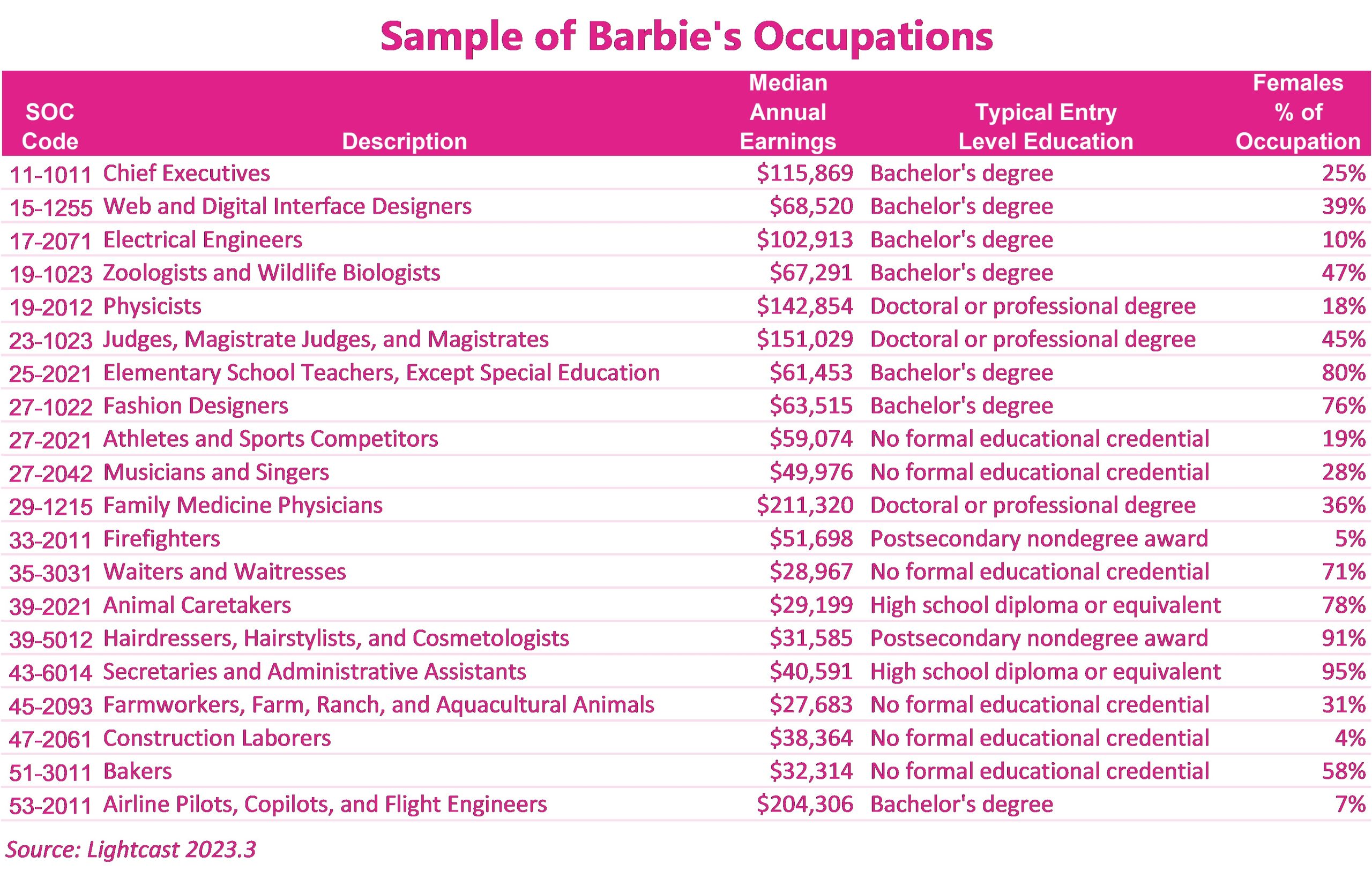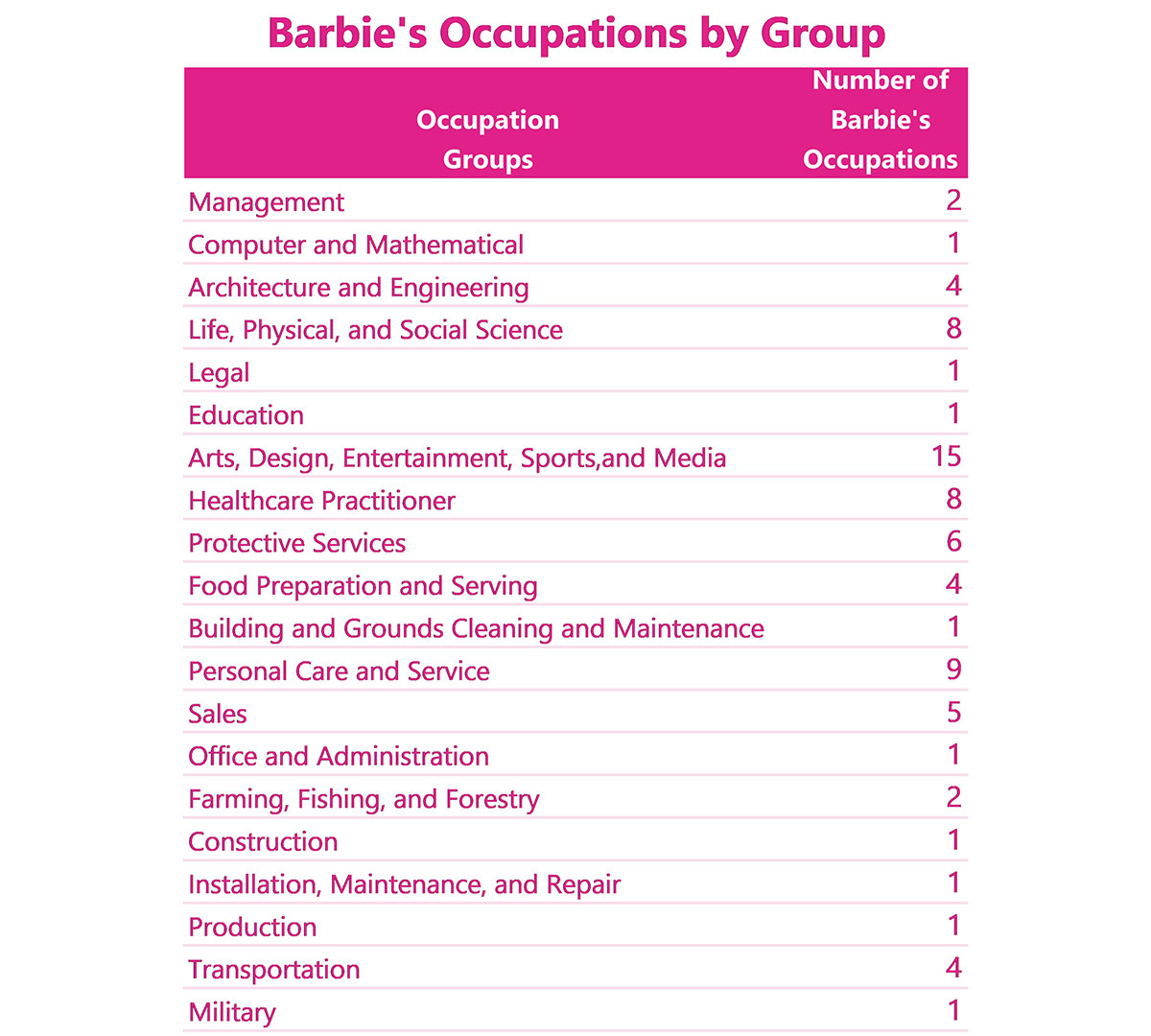
The author’s favorite Barbie when she was a child was Air Force Barbie, originally released in 1991.
Photo source: Barbiemedia.com
Barbie’s creator Ruth Handler once said, “Barbie always represented the fact that a woman has choices.” But what do Barbie’s career choices say about her, and therefore about the state of women in the workforce?
Since her creation in 1959, Barbie has had over 250 careers ranging from cheerleader to robotics engineer and everything in between. For this analysis, 119 of Barbie’s jobs were mapped to 76 distinct Standard Occupational Classification (SOC) codes.
The following table shows a small sample of Barbie’s many jobs, along with the earnings, educational requirements, and share of females working in that occupation at the national level.
 Many of Barbie’s jobs fall into a single SOC code. For example, she has been a tennis pro, Olympic skier, figure skater, gymnast, and many more occupations that fall into the SOC 27-2021 occupation: Athletes and Sports Competitors.
Many of Barbie’s jobs fall into a single SOC code. For example, she has been a tennis pro, Olympic skier, figure skater, gymnast, and many more occupations that fall into the SOC 27-2021 occupation: Athletes and Sports Competitors.
Barbie has worked in 20 of the 23 major occupation groups. Her most common occupations are in Arts, Design, Entertainment, Sports, and Media (20% of her occupations). She has never had a Business and Finance job. She has never worked in Community and Social Services or Healthcare Support (although she has been a Healthcare Practitioner).
 Barbie is more likely to work in a male-dominated field than most US women. Nearly 60% of Barbie’s jobs have been in male-dominated fields (defined as occupations with at least 52% male workers, which is the male share of total jobs in the US economy).
Barbie is more likely to work in a male-dominated field than most US women. Nearly 60% of Barbie’s jobs have been in male-dominated fields (defined as occupations with at least 52% male workers, which is the male share of total jobs in the US economy).
This means she is likely outperforming most women in the US economy. Women in the US earn 82 cents for every dollar earned by men, which is better than it ever has been. However, wage gains have stalled and there is still much progress to be made. And the gender pay gap is even more pronounced for women of color.
A portion of the gender pay gap can be explained by occupational segregation, as women tend to work in fields that pay less. According to the American Association of University Women, women account for over 78% of the workforce in low-wage jobs despite only accounting for nearly 48% of the total workforce. Male-dominated fields usually pay better, even when female-dominated fields require the same level of education and skill.
When Barbie works in male-dominated fields, she needs significantly more education. Only 23% of Barbie’s jobs in female-dominated fields require a college education (and none require above a bachelor’s degree), whereas 58% of Barbie’s jobs in male-dominated fields require a bachelor’s degree or above (20% require a doctoral or professional degree).
Unsurprisingly, when Barbie works in male-dominated fields, she earns significantly more than most women. In Barbie’s jobs in female-dominant occupations, her average median earnings are $45,651, compared to $86,348 for her jobs in male-dominated fields.
Other workforce characteristics about Barbie worth noting: Barbie is highly educated and close to retirement. Over 43% of Barbie’s occupations require a Bachelor’s, doctoral, or professional degree. That places her within the 34% of the nation’s workers with similar levels of education.
Barbie is probably close to retirement. It’s been 64 years since Barbie was introduced (although she was supposed to be 19 at the time, meaning she technically would be 83 years old now). This puts her alongside the 9% of the nation’s workers that are aged 65 and over.
Other occupations Barbie ought to consider: Business and Finance jobs pay well, with median annual earnings of $74,506, and she already has the education to qualify for a job.
Given the major investments in infrastructure in the US currently, she would do well to consider the skilled trades. Women have been historically underrepresented in the trades, a fact the field is desperately trying to remedy given widespread labor shortages.

Or perhaps she should consider installing broadband as a Telecommunications Equipment Installer, earning $57,909 per year with a high school diploma and relatively minimal training (just think of all the money she could have saved on student loans!).
So, while Barbie has certainly worked in plenty of jobs that can be considered traditionally female, she’s made a lot of progress in breaking through the glass ceiling. Barbie continues to be an aspirational example of what happens when women pursue careers (and education and training) outside of traditional roles.
If you’d like to learn more about how to promote workforce equity and prepare the Barbies and Kens (and Allen!) in your community for the workforce of the future, please contact us!
Learn more about our Workforce Development and Talent Attraction Services
All data is sourced from Lightcast unless otherwise noted.






